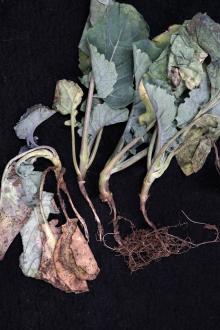Cause The fungi or fungus-like microorganisms, Pythium spp., Fusarium spp. and Rhizoctonia solani, attack young seedlings of many vegetables including members of the genus Brassica. These soilborne microbes can persist indefinitely in soil or plant debris. If seedlings are affected before emergence, it appears as poor germination. If the decay is after emergence, seedlings that fall over and die have "damping-off." The destructiveness of this disease depends on the number of pathogens in the soil and on environmental conditions. Cool, cloudy weather, wet soils, compacted soil, acidic soil, high humidity, and overcrowding are especially favorable for the development of damping-off.
Symptoms Young seedlings develop a sunken, necrotic lesion near the soil line. If the lesion girdles the stem, the seedling collapses and soon dies. Also, seeds may simply not emerge.
Cultural control
- Use good quality seed.
- In the greenhouse or seedbed, pasteurize the soil with heat. Use good sanitation in greenhouses.
- Locate seedbeds on well-drained soil and avoid excessive irrigation.
- Lime acid soils to get a pH of 6.5 or 7.0.
- Space rows and/or seedlings in the seedbed to maximize air movement.
- Carefully examine seedlings when transplanting, and discard any with signs of wirestem.
- If damping-off occurs, stop watering for a while. Allow soil to dry somewhat around the plants. If the seedlings are in flats or in cold frames, give them as much air and light as possible.
- Crop rotation with cereals may reduce pathogen populations in the soil.
- Remove or encourage decomposition of plant debris.
Chemical control
Seed treatment
- Allegiance-FL (Group 4) at 0.75 fl oz/100 lb seed plus a dye can be used where Pythium spp. are a problem. See label for reentry restrictions.
- Apron XL (Group 4) at 0.085 to 0.64 fl oz/100 lb seed plus a dye, can be used where Pythium spp. are a problem. See label for reentry restrictions.
- Captan 4F (Group M4) at 2.2 fl oz/100 lb seed plus a dye.
- Dynasty (Group 11) at 0.10 to 0.38 fl oz/100 lb seed plus a dye. 4-hr reentry.
- Maxim 4FS (Group 12) at 0.08 to 0.16 fl oz/100 lb seed plus a dye. To control pathogenic Fusarium and Rhizoctonia spp. See label for reentry restrictions.
- 42-S Thiram (Group M3) at 8 fl oz/100 lb seed plus a dye. See label for reentry restrictions.
Soil treatment
- MetaStar 2E AG (Group 4) at 1 to 2 pints/A at planting. For control of Pythium spp. 48-hr reenty.
- Quadris Flowable (Group 11) at 0.4 to 0.8 fl oz/1000 row feet applied in a 7-inch or less band either in-furrow at planting or as a directed spray at cultivation. 4-hr reentry.
Biological control
- Actinovate AG at 3 to 12 oz/A as a soil drench at planting. 4-hr reentry. O
- Actinovate Lawn & Garden at 1/2 to 1 teaspoon/gal water. H O
- Bexfond at 7 to 14 fl oz/A. 4-hr reentry. O
- Bio-Tam 2.0 at 2.5 to 5 lb/A as a broadcast at sowing. See label for different methods and rates of application. 4-hr reentry. O
- Cease at 3 to 6 quarts in 100 gal water applied to soil at 1 pint/sq ft for each 3-inches of soil depth on 21- to 28-day intervals. For greenhouse plants only. 4-hr reentry. O
- Double Nickel LC at 1 to 2 quarts/A as a banded soil spray or drench 4- to 6-week intervals or at 0.5 to 4.5 pints/A on 2- to 4-week intervals. Can be applied the day of harvest. 4-hr reentry. O
- Mycostop at 0.07 oz/half lb seed. 4-hr reentry. O
- Rootshield WP at 3 to 8 oz/100 gal water for greenhouse soil drench and field chemigation, or at 16 to 32 oz/A as an in-furrow spray. 4-hr reentry. O
- SoilGard at 2 to 10 lb/A at 4-week intervals will suppress Pythium and Rhizoctonia. See label for specific application types and timings. Can be applied on the day of harvest. 4-hr reentry. O
- Tenet WP at 2.5 to 5 lb/A as a broadcast at sowing. See label for different methods and rates of application. 1-hr reentry. O


